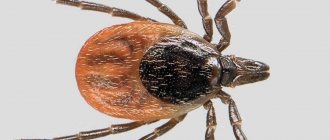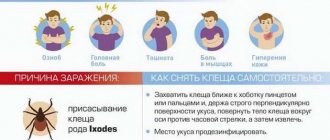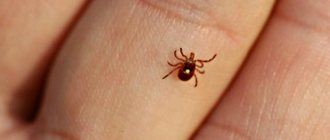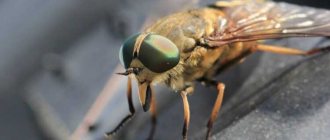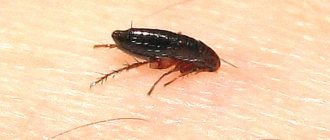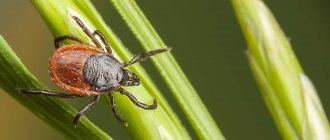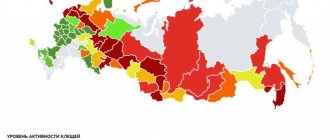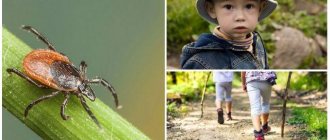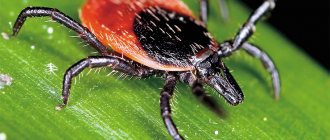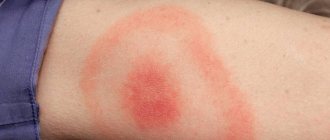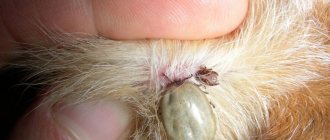We must never forget that a person is a potential victim of ticks, which are carriers of most dangerous viruses, among which tick-borne encephalitis ranks first. Blood-sucking ticks live almost everywhere. They can lie in wait for their prey in the forest, in the field, in pastures, as well as in premises where animals are kept. Despite the diversity of species, the greatest threat to humans is posed by the grass tick, which attaches itself to the body imperceptibly and painlessly. As a result, the person may not even be aware of the bite.
Basics of ethology of pasture ticks
The active type of attack of pasture ticks allows them to quickly detect potential food and spend as little time as possible outside the shelters. Guided by the sun, they visually determine the shortest path to food and launch an attack.
However, pasture ticks (dermacentor marginatus), which live in damp and cool conditions, rarely attack openly. Most often, they set up a kind of ambush on plants in anticipation of a prey, to detect which they use chemical signals emanating from any living creature. However, it should be noted that the grass tick cannot recognize whether the odor source is suitable for feeding, and reacts even to non-specific odors. Foraging for food in such conditions is associated with active movements to places where ticks sense the odor emanating from people and animals.
Monitoring
Vulnerable pastures and crops should be closely monitored from spring through fall for mites and signs of damage.
Important!
It is especially worth checking crops regularly in the first three to five weeks after sowing.
Those plants most at risk are those that are sown in separate areas that took a break from cultivated crops last year, that is, where there used to be pasture or weeds grew. Warm, mild autumn will promote the spread of ticks. Pasture mite populations tend to decline during wet, cold autumns, so this option can often lead to the complete disappearance of the parasite from a given field.
Weeds present in and around fields should be checked for the presence and abundance of pasture mites. Insects are best found on warm days from midday to late evening, and more difficult to spot in cool, damp weather. As already noted, mites crawl out to feed on the outer surface of the leaves, where they are easier to see, and their cobwebs are also sure to catch your eye.
Sexual differences in pasture ticks
The pasture tick, whose size in a hungry state rarely exceeds 6 mm, can increase up to 2 cm. Moreover, it can be distinguished from other varieties not only by its unique dimensions, but also by its appearance.
The upper part of their body is covered with a dense dorsal shield, by which the gender of an individual can be determined. In males it covers the entire upper part of the body, while in females and larvae at all stages of development it covers only the front part. In addition, females suck several times more blood than their own body weight, as a result of which they swell so much that they begin to resemble a large bean, while the male requires much smaller volumes of blood for normal functioning. It is noteworthy that females are much more often carriers of serious diseases, contributing to the emergence and maintenance of natural foci of viral infections.
Prevention
There is no specific prevention against borreliosis; there is a vaccine for people against tick-borne encephalitis. The direct route of infection with dangerous diseases is the bite of an infected pasture tick, but there are also known cases of infection through consumption of raw milk. To prevent the disease, you must follow the rules of your own safety when you are on the pasture, near animals, treat livestock with repellents, and treat milk before consumption.
Reproduction
Considering the large number of species, when going out into nature, a person must definitely think through safety measures and the seriousness of the consequences that a tick on the body can lead to. The photo presented below allows us to judge the volume of blood that the female needs to consume to increase from a few millimeters to similar sizes.
After the female is completely satiated, she falls to the ground and, having selected a suitable shelter for herself, begins laying eggs. In this case, fertilization of females occurs even during the period of saturation on the host’s body. Typically, laying is done in burrows, sand, fallen leaves, or in buildings where farm animals are kept. This place is ideal not only for its temperature characteristics, but also allows newly hatched ticks to gain quick access to food, since the larvae are born extremely hungry.
What to do next with brown mites
If you have removed ticks from a dog, carefully monitor its well-being in the coming days. At the first signs of deterioration in health and loss of coordination, you should consult a doctor. Ideally, immediately after removing the ticks, the dog should be taken to the veterinarian and have the necessary tests done to identify infections.
When you remove a tick from yourself or another person, you must urgently submit it for analysis to:
- Center for Hygiene and Epidemiology in Moscow.
- Center for Hygiene and Epidemiology of the Moscow Region (Mytishchi).
- A commercial laboratory that offers tick analysis services (Hemotest, Invitro, etc.)
If pathogens of any infections are found in the tick, you can consult a doctor and begin treatment in the early stages. In all institutions, tick analysis is done only on a paid basis.
Larval development
It is noteworthy that the newly hatched larva does not have genitals at birth, and only after a few days of continuous feeding, after the individual has molted, it transforms into a nymph, which in size is very similar to an adult tick.
The pasture tick, whose life cycle has characteristic features and is quite complex, includes several stages of transformation: from larvae to adult. It needs a minimum amount of time to fully develop. The speed of its development directly depends on climatic conditions and the timely finding by the larva of a constant source of food for this period. The larva feeds for about three days, after which it undergoes its first moult, after which it transforms into a nymph.
The pasture tick remains in the nymph stage for about a week, after which another molt occurs, as a result of which the individual transforms into an adult, and the development cycle of the pasture tick is completed.
Habitat, lifestyle
Ixodid ticks are found everywhere; pasture ticks live mainly in meadows where livestock graze. The life cycle of the parasite extends over several years.
- The female lays eggs in soil with rotten leaves and grass. From there the first instar larvae emerge.
- Parasites wait for a warm-blooded animal to feed on blood. Often the first victim is a small rodent. After saturation, the larva falls to the ground and continues development. She molts and turns into a nymph.
- Hungry immature ticks can wait for months for a victim in the grass, on the lower branches of bushes. Pasture parasites feed on animals that are grazed in meadows or animals. He bites once and falls to the ground again. If the life cycle of development occurs in autumn, the pasture tick overwinters in this state and continues to develop in the spring.
- Adults live for about 2 months, feed on the blood of animals and people. During this time, the female lays up to 1,700 eggs, but half survive.
Favorable conditions for development are high humidity and high air temperatures within 22-25 degrees Celsius. Activity decreases with the onset of cold weather and hot summers.
Pasture mite
On a note!
During the season, pasture ticks become active twice - May-June, August-September. They are absent in July and early August; they disappear in October after a persistent decrease in temperature. In rainy summers, ticks on pastures are active throughout the season.
Most common types
Despite the fact that ticks are found almost everywhere and there are a large number of different species, the most widespread are:
- Ixodes persulcatus is a fairly aggressive species towards humans. Ticks of this group become most active in the 2-3rd year of life. It lives almost everywhere and poses a serious threat.
- Ixodes ricinus is a tick not exceeding 3 mm in size. In the initial stage of development, they are firmly attached to small rodents and birds, and as they grow older they move to large and medium-sized livestock. If the larvae are born in natural conditions, they use hares and hedgehogs as the main sources of food, upon which the ticks will attach themselves and feed at all stages of development. This species is most widespread in America, Western Europe and Russia.
- Dermacentor marginatus. It is quite simple to distinguish ticks of this species from other representatives; it is necessary to carefully examine the dorsal shield of the individual. Its side part is dark brown and decorated with light patterns. The adult stage of dermacentor marginatus begins already at the end of March, allowing them to actively parasitize even before the onset of final warming and the awakening of most species of ticks. Most often they can be found in meadows and bushes, as a result of which they are much more likely than other species to use human blood as the main source of food, attacking people both during outdoor recreation and in urban environments.
- Dermacentor pictus. Ticks of this species are capable of absorbing large volumes of blood, which in the future will lead not only to loss of strength, but also to anemia.
In this case, these types can be divided into three categories:
- A tick that, at any stage of development, lives on one host.
- A tick that, while on its original host, simultaneously selects a new source of food for itself.
- A tick that randomly chooses its hosts throughout its life.
Biological characteristics of the insect
The pasture mite, or clover mite, entomologically belongs to the Bryobia family. These insects have relatively recently been identified as pests of winter crops and pastures in the southern parts of our country. This mite was first reported in the early 1900s, but has only been actively studied and controlled in the last decade, as the insects were identified as pests capable of causing significant damage in crop production.
It is worth noting that control of parasites is complicated by the large number of tick species, as well as their small size and lack of suitable morphological characteristics, which makes identification a rather difficult process.
In Russia, there are at least seven different Bryobia species living among wide expanses of agricultural land and pastures.
Of these seven types, three are the most common. It is against them that a purposeful struggle must be waged.
The influence of pasture ticks on humans
- If the integrity of the tick's skin is damaged during removal from the body, various pathogens of viral diseases can enter the human body.
- If the bite site is not treated in a timely manner, the saliva produced by the tick can lead to a serious allergic reaction, which can subsequently cause fever and many nervous diseases.
- They can carry many different viruses that are inherited in pasture ticks: from the female to the larvae.
Medical significance
Pasture ticks are dangerous for spreading various diseases.
- Lyme disease or borreliosis;
- tick-borne encephalitis;
- tularemia;
- ehrlichiosis;
- babesiosis;
- fever;
- relapsing fever;
- helminthic infestation.
Important!
The most dangerous infections are borreliosis and tick-borne encephalitis. Infection occurs through the bite of an infected pasture tick. The incubation period lasts on average 14 days. The first symptoms are similar to the flu. It begins acutely with fever, headache, muscle aches, photophobia, etc.
The acute phase of borreliosis, tick-borne encephalitis lasts about 10 days. After this, either the disease recedes, immunity is developed, or continues to progress. The next exacerbation occurs within a month, the manifestations are stronger and longer lasting. In the absence of qualified therapy, paralysis, paresis, disability, dementia, visual impairment, hearing impairment, and death occur. Tick-borne infections affect the brain, central nervous system, and muscles.
Precautionary measures
As a basic preventative measure, it is recommended to wear clothing that completely covers exposed areas of the body when going outdoors. In addition, after being in the forest or field, be sure to carry out preventive examinations, as a result of which the detected tick on the body (a photo of a similar case is presented below) is carefully removed along with the proboscis. Try not to damage its integrity. If it is disrupted during the extraction process, a viral infection may enter the body. It must be remembered that if a pasture tick infects farm animals, then through their milk, which has not undergone special treatment, the infection can be transmitted to humans.
At the same time, be sure to keep in mind that even if you are sure that the pasture tick was removed without violating its integrity, be sure to undergo a preventive medical examination, which will help to timely detect and begin treatment of a possible viral infection.
Ways to fight
Individual protective measures against dermacentras are the same as protective measures against ixodids. When going for a walk in the forest, you need to wear special clothes that will not allow bloodsuckers to get to your body. Animals are protected with the help of acaricidal preparations for dogs and products for cats, which are equally effective on both dermacents and ixodids.
When returning from the forest, the body is carefully examined. The attached ticks of all genera and families are carefully removed, placed in a small container and submitted for analysis.
